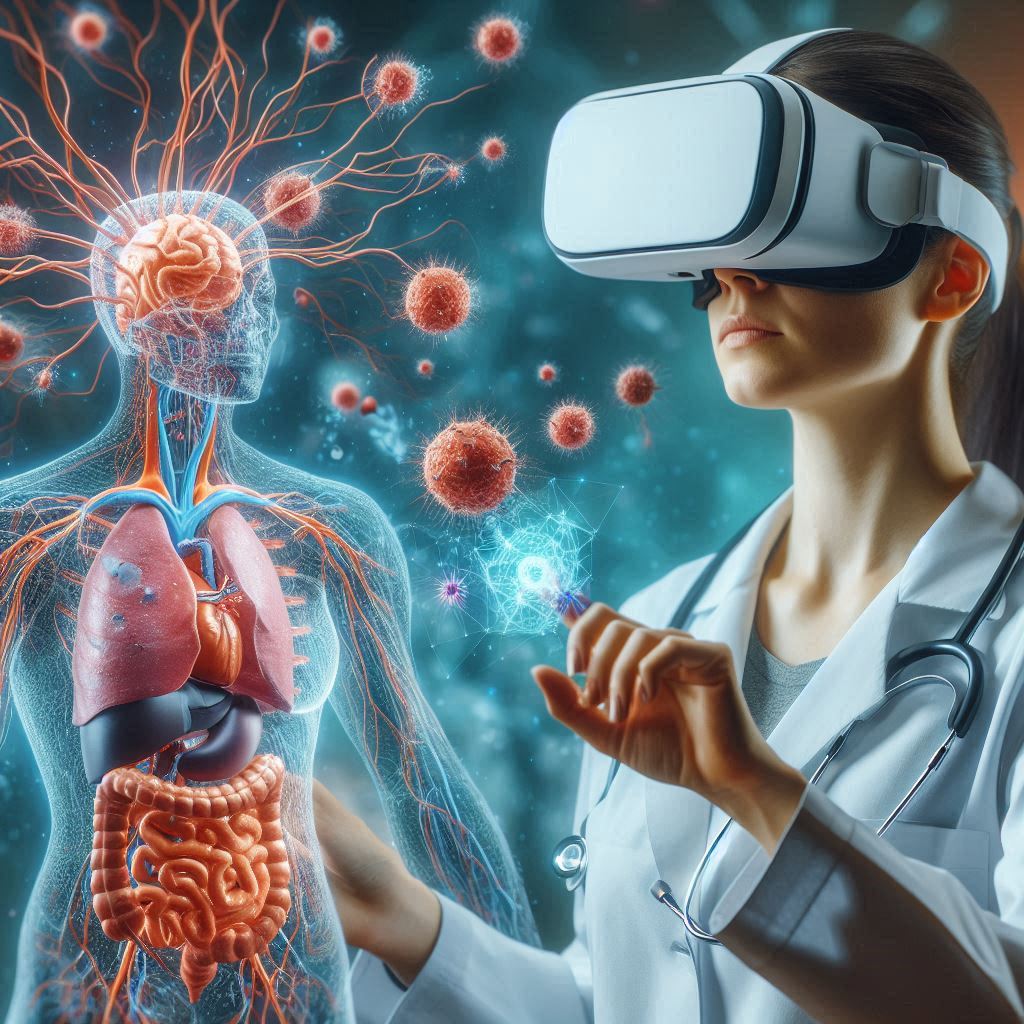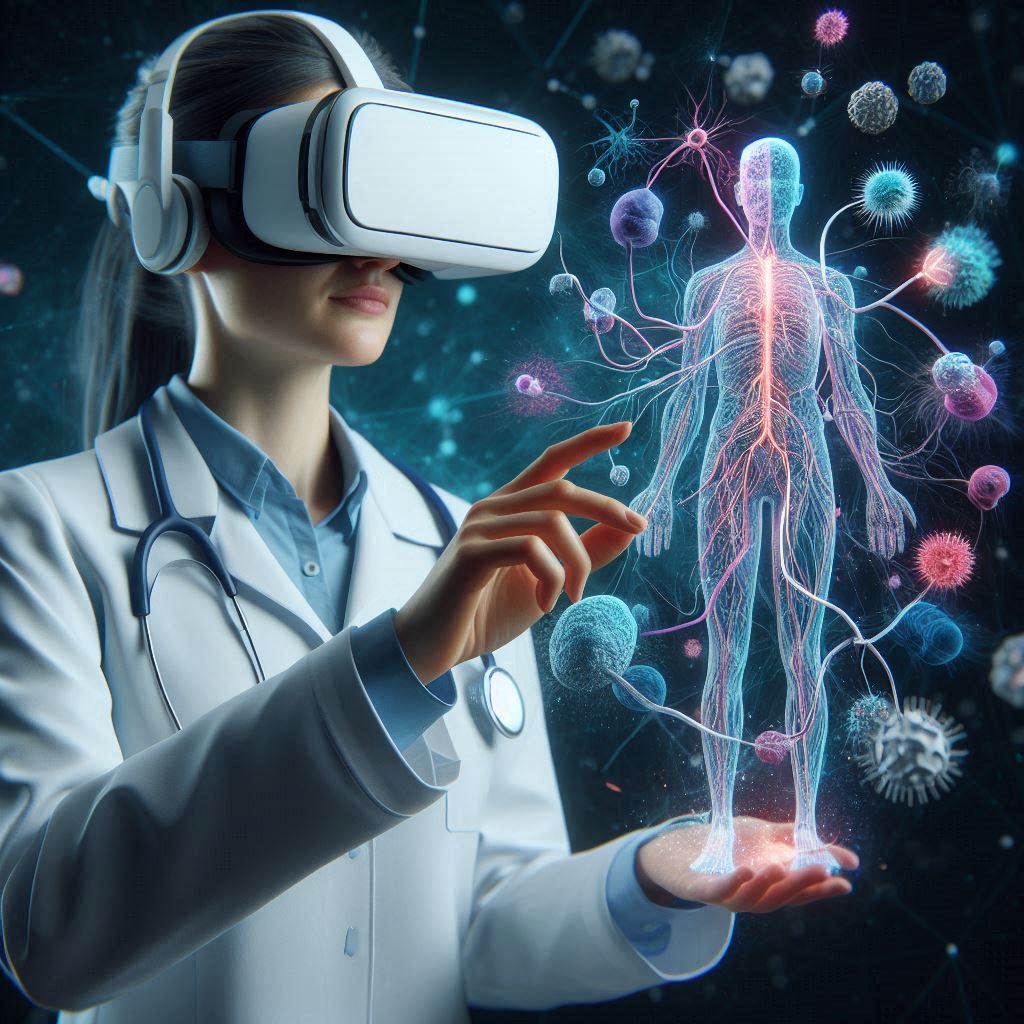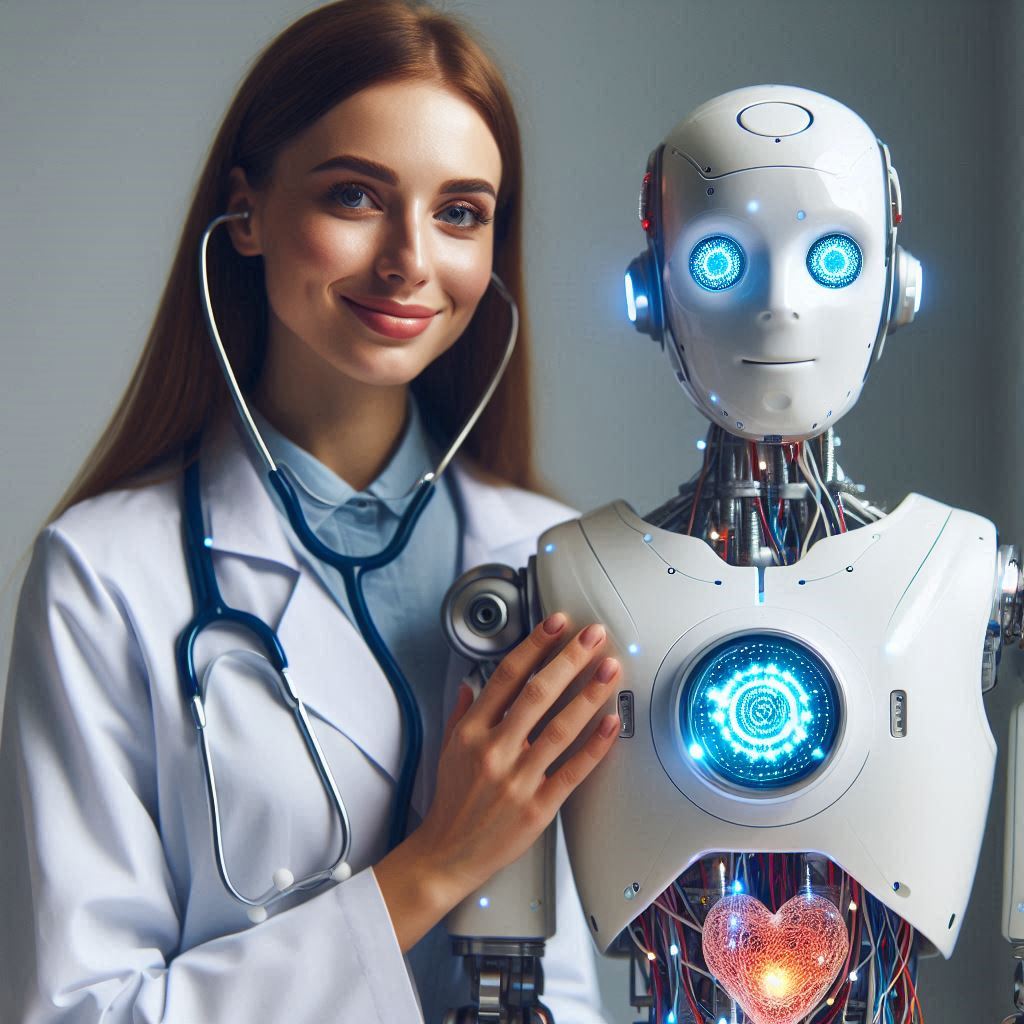Introduction
Overview of the evolution of medical training
Medical training has evolved remarkably over the centuries.
Traditionally, it relied heavily on lectures and textbooks.
Later, hands-on experience in clinical settings became essential.
Today, technology introduces new modalities to enhance learning, particularly Virtual Reality (VR).
Introduction to Virtual Reality (VR) and its significance in various fields
VR is a groundbreaking technology that immerses users in three-dimensional environments.
It allows for real-time interaction within simulated scenarios.
This technology has gained traction across various fields, including gaming, education, and healthcare.
In healthcare, VR has emerged as a transformative tool, enhancing training and skills development.
Purpose of the blog post: to explore how VR is transforming medical training
This blog post aims to explore how VR is revolutionizing medical training.
By incorporating immersive simulations, healthcare professionals can practice their skills in a safe setting.
They can refine their techniques before encountering real-life situations.
Such an approach significantly reduces the risk of errors in high-stakes environments.
Furthermore, VR provides diverse training opportunities.
Aspiring surgeons can perform virtual surgeries without the need for live patients.
This experience fosters confidence and competence in their abilities.
Additionally, VR can recreate complex medical scenarios commonly faced in emergency rooms.
With VR, medical students can also learn about patient interactions.
They can practice communication skills through simulated patient encounters.
This immersive experience prepares them for real-world challenges, enhancing their interpersonal skills.
Additional points
Moreover, VR allows tailored learning experiences.
Instructors can modify scenarios based on individual student progress.
This adaptability ensures that training is relevant and effective for each learner.
Research shows that VR training enhances knowledge retention.
Participants often find VR modules engaging and interactive.
This increased engagement leads to deeper learning and better skill acquisition.
As VR technology continues to advance, its applications in medical training will only expand.
The integration of VR in healthcare education promises to produce well-prepared professionals ready to tackle today’s medical challenges.
In this blog, we will delve into specific case studies and examples that illustrate the benefits and effectiveness of VR in medical training.
Understanding Virtual Reality
Definition of Virtual Reality
Virtual Reality (VR) immerses users in a computer-generated environment.
It creates a simulated experience that can mimic the real world.
Users feel they are part of this virtual space through sensory stimulation.
This stimulation often includes visual, auditory, and sometimes tactile feedback.
VR enables various interactive experiences, engaging all the senses.
The technology behind VR (hardware and software components)
VR technology consists of both hardware and software elements.
Each component plays a vital role in creating immersive experiences.
Put Your Tech Company on the Map!
Get featured on Nicholas Idoko’s Blog for just $50. Showcase your business, boost credibility, and reach a growing audience eager for tech solutions.
Publish NowHardware Components
- Head-Mounted Displays (HMDs): These devices place screens close to the user’s eyes. They provide a stereoscopic view, creating depth.
- Sensory Devices: Motion tracking sensors, gloves, and controllers enable users to interact with the virtual environment. They capture movements and translate them into the VR world.
- Audio Systems: 3D sound systems enhance the immersive experience. They allow users to perceive sounds spatially, mimicking real-world audiovisual connections.
Software Components
- Game Engines: Software platforms like Unity or Unreal Engine create VR simulations. They facilitate realistic graphics and physics.
- Content Creation Tools: These tools provide developers with the assets needed to build virtual environments. They usually allow for rich customizability.
- Simulation Software: This software mimics real-world scenarios for training purposes. It often focuses on specific industries, including healthcare.
History and development of VR in various industries
The concept of virtual reality has roots in the mid-20th century.
Inventors and enthusiasts experimented with ways to simulate reality.
However, VR gained prominence in the 1990s, driven by technological advancements.
Interest in gaming and entertainment played a significant role during this period.
As technology evolved, VR found applications in various industries, including healthcare.
Developers recognized VR’s potential for education, training, and rehabilitation.
- Entertainment: The gaming industry embraced VR early on. Titles like “Half-Life: Alyx” revolutionized how players engage with digital narratives.
- Training and Simulation: Aviation and military sectors adopted VR for realistic training exercises. They utilized simulations that mimic real-world scenarios without risks.
- Healthcare: Medical professionals quickly saw the advantages of VR. It allows for hands-on practice, enhancing skills and virtually reducing the learning curve.
- Education: Educational institutions incorporated VR into curricula. It facilitates immersive learning experiences, making complex subjects more comprehensible.
Today’s innovations continue to advance VR technology.
As hardware and software improve, the applications of VR grow wider.
The healthcare sector, in particular, benefits immensely from these advancements.
From education to rehabilitation, VR creates a myriad of opportunities.
By understanding how VR works, we can appreciate its impact on fields, especially healthcare.
The technology represents a crucial step forward in enhancing medical training and patient care.
Read: Blockchain in Health Tech: Securing Patient Data
Current Challenges in Medical Training
Medical training has long relied on traditional methods.
These methods include lectures, textbooks, and hands-on clinical practice.
However, as healthcare evolves, so too must the training of healthcare professionals.
Multiple challenges currently hinder the effectiveness of traditional medical training.
Below is a detailed examination of these challenges.
Overview of Traditional Medical Training Methods
Traditionally, medical training consists of several core components:
- Classroom Learning: Instructors deliver lectures on anatomy, pathology, and pharmacology.
- Textbook Study: Students immerse themselves in textbooks to understand medical concepts.
- Clinical Rotations: Students gain direct experience in various medical specialties through supervised rotations.
- Simulation Labs: Some schools offer simulation labs for practice on dummies or high-fidelity mannequins.
These methods have served the industry for decades.
However, they come with numerous limitations and shortcomings that hinder the overall educational experience.
Limitations and Risks Associated with Hands-On Training
The hands-on component of medical training is crucial.
Yet, it poses significant risks and limitations:
- Patient Safety: Trainees often perform procedures on real patients, risking safety and outcomes.
- High-Stakes Environments: Medical training environments can be stressful, which may impact performance.
- Limited Practice Opportunities: In many cases, students have a limited number of clinical cases to learn from.
- Variability in Training Quality: Not all institutions provide the same quality of hands-on training.
These risks suggest a need for alternative training methods.
The focus must shift towards safer and more effective educational solutions.
Issues of Accessibility and Standardization in Medical Education
Accessibility to medical education presents another challenge.
This issue varies by geographic location and economic background:
- Geographic Barriers: Many aspiring medical professionals live in remote areas lacking educational facilities.
- Economic Disparities: The high cost of medical education deters many talented individuals from pursuing healthcare careers.
- Standardization Concerns: Different institutions may have varying curricula, leading to inconsistency in training.
- Lack of Resources: Many medical schools cannot provide the newest technology or sufficient clinical exposure due to funding constraints.
Tackling these issues is essential for developing a more equitable healthcare education system.
As challenges persist, the question arises: how can we enhance medical training?
By recognizing these challenges, we open pathways for innovation.
Virtual Reality (VR) introduces significant potential to address these issues and transform medical education.
VR technology allows students to immerse themselves in realistic medical scenarios.
This approach provides safe and controlled environments for training.
It also overcomes many limitations associated with traditional methods.
Additional points
Here’s a closer look at what VR can offer:
Put Your Tech Company on the Map!
Get featured on Nicholas Idoko’s Blog for just $50. Showcase your business, boost credibility, and reach a growing audience eager for tech solutions.
Publish Now- Safe Learning Environment: Students can practice procedures without harming real patients.
- Repetition and Mastery: VR allows for repeated practice of skills until mastery is achieved.
- Access to Diverse Cases: Trainees can encounter a wide variety of medical scenarios, enhancing learning.
- Standardized Training: VR can deliver consistent training experiences across different institutions.
This technology reduces risks and improves the learning curve.
Higher patient safety and better-trained professionals can result from adopting VR in medical curricula.
Additionally, VR addresses accessibility issues.
Students in remote locations can access high-quality training, reducing geographical barriers.
With VR, students no longer need to travel to specialized centers for advanced training.
This innovation also diminishes costs associated with conventional training methods.
As the healthcare landscape becomes increasingly complicated,
it’s critical to rethink medical education.
Virtual Reality provides a refreshing solution to enduring challenges.
By integrating VR into medical training, we lay the foundation for a future where healthcare professionals receive superior education and training.
In general, traditional medical training faces significant challenges.
The limitations of hands-on training and issues of accessibility hinder the effectiveness of education.
Virtual Reality introduces revolutionary changes, making training safer and more effective.
By adopting VR technology, we can overcome existing barriers and enhance medical education.
Ultimately, this leads to better-prepared healthcare professionals and improved patient outcomes.
Read: Data Analytics in Healthcare: Driving Precision Medicine
Benefits of VR in Medical Training
Virtual reality (VR) has emerged as a transformative tool in medical training.
It offers immersive and engaging experiences that enhance learning outcomes for healthcare professionals.
This section explores the numerous benefits of VR in the realm of medical education, focusing on immersive simulations, knowledge retention, and safe learning environments.
Immersive Simulations and Their Impact on Learning
One of the standout features of VR in medical training is its immersive simulation capabilities.
These simulations replicate real-life medical scenarios, providing trainees with unparalleled lifelike experiences.
- Realistic Environments: VR creates a 3D environment where students can interact with virtual patients.
This realism enhances the learning experience and bridges the gap between theory and practice. - Interactive Learning: Trainees can practice procedures repeatedly. This interaction fosters a deeper understanding of complex medical concepts and enhances critical thinking skills.
- Immediate Feedback: VR programs often include real-time performance assessments. Instant feedback allows learners to recognize mistakes and improve their skills on the spot.
The impact of immersive simulations on learning can be profound.
Studies show that students trained using VR outperform their peers in traditional settings.
They demonstrate higher proficiency in skills and improved diagnostic accuracy.
Enhanced Retention of Knowledge and Skills Through Experiential Learning
VR not only provides immediate learning benefits but also significantly improves knowledge retention.
Experiential learning plays a crucial role in solidifying this knowledge.
- Engagement: VR captivates users through interactive components. This engagement keeps students interested and increases motivation to learn.
- Active Participation: In VR, learners are active participants in their education. Engaging in hands-on practice reinforces concepts and facilitates deeper understanding.
- Emotional Connection: Immersive experiences evoke emotions, creating memorable learning moments. Emotional connections help in retaining critical information longer.
The combination of these elements fosters enduring knowledge retention.
Research indicates that experiential learning in VR results in a significantly longer retention rate than traditional methods.
Safe Learning Environments for High-Risk Procedures
Medical training often involves high-stakes scenarios.
VR provides a safe environment for trainees to practice and hone their skills without jeopardizing patient safety.
- Risk-Free Practice: Students can perform complex procedures without the fear of harming real patients. This freedom encourages experimentation and learning from mistakes.
- Repetition without Consequence: Trainees can repeat surgeries or procedures as many times as necessary. This repetition builds confidence and proficiency before encountering real-life situations.
- Focused Training: VR allows educators to customize training sessions. Instructors can tailor scenarios to address specific skills or knowledge gaps in students.
This safe learning environment not only enhances skills but also helps in developing decision-making abilities.
Trainees learn to assess situations quickly and make informed choices in high-pressure moments.
The integration of virtual reality in medical training offers transformative benefits that enhance learning outcomes.
Immersive simulations allow for realistic and interactive learning experiences.
These experiences lead to better knowledge retention and skill proficiency.
Put Your Tech Company on the Map!
Get featured on Nicholas Idoko’s Blog for just $50. Showcase your business, boost credibility, and reach a growing audience eager for tech solutions.
Publish NowMoreover, the safety provided by VR training environments enables trainees to practice high-risk procedures with confidence.
As such, VR stands as a powerful educational tool that equips future healthcare professionals with the skills they need to thrive in their roles.
As technology continues to evolve, the potential for VR in medical training grows.
This innovation not only keeps pace with advances in healthcare but also shapes the future of medical education.
Clearly, VR is changing the landscape of medical training, paving the way for a brighter future in healthcare education.
Read: Telemedicine Platforms: The Future of Healthcare Delivery

Case Studies and Examples
Virtual reality (VR) has revolutionized medical training and education.
As medical schools adopt innovative VR programs, they reshape how future healthcare professionals learn.
Below, we explore some of the groundbreaking VR initiatives currently in use, along with success stories and feedback from medical practitioners.
Innovative VR Programs in Medical Schools
- Stanford University: Stanford’s immersive virtual reality lab offers a revolutionary program called “Virtual Reality for Healthcare.”
The program simulates a range of clinical scenarios, providing students with realistic patient interactions and decision-making experiences. - Harvard Medical School: Harvard has integrated VR technology into their anatomy courses.
Students can explore 3D models of the human body, enhancing their understanding of complex structures.
This approach allows learners to visualize anatomy in a way traditional methods cannot. - University of Michigan: The University of Michigan employs VR in surgical training. They created simulations that mimic real surgical environments.
Trainees can practice various procedures without risk, accelerating their learning curve. - University of South Carolina: Their School of Medicine features a VR program for emergency medicine.
The program immerses students in high-stress situations, such as managing cardiac arrests.
This hands-on practice prepares them for real-life emergencies. - Johns Hopkins University: Their VR initiative includes a detailed program for neurosurgery.
Students can practice intricate surgeries through realistic scenarios.
This program significantly improves fine motor skills and spatial awareness in surgical contexts.
Success Stories from VR Training
- Improved Surgical Skills: A study conducted at the University of Maryland revealed that students who underwent VR training demonstrated a 25% increase in surgical proficiency.
Their performance in real surgeries improved significantly compared to those who trained using traditional methods. - Enhanced Patient Interaction: At Stanford, students engaging in VR simulations reported greater confidence in handling patient interactions.
They felt better prepared to communicate complex information effectively.
This confidence translated to improved patient satisfaction in their later clinical practice. - Reduced Errors in Procedures: The University of Michigan found that residents who trained in surgical VR environments had a significantly lower error rate during their first year.
This decrease in mistakes led to better patient outcomes and fewer complications during surgeries. - Stress Management Training: The University of South Carolina’s VR program improved students’ abilities to handle stress.
Participants reported feeling more equipped to manage high-pressure situations.
This newfound resilience paved the way for better performance in emergency scenarios. - Accelerated Learning Curve: A joint study at Harvard and Johns Hopkins uncovered that students who trained with VR technologies learned complex anatomical structures more quickly.
The immersive experience promoted faster recall of information during exams.
Testimonials from Medical Professionals
- Dr. Sarah Thompson, Surgeon at the University of Michigan: “The VR training program transformed my approach to surgery.
I feel more prepared, and my skills have improved tremendously since I started using it.” - Dr. James Collins, Resident at Stanford University: “The virtual simulations created a safe space to make mistakes and learn from them. The confidence it gave me is invaluable in real-life scenarios.”
- Dr. Laura Kim, Emergency Medicine Physician at the University of South Carolina: “The VR program taught me how to manage emergency situations calmly.
I perform better under pressure now because of this unique training.” - Dr. Kevin Zhang, Neurosurgeon at Johns Hopkins University: “Practicing complex procedures in virtual reality improved my fine motor skills.
It enabled me to refine my abilities before operating on actual patients.” - Dr. Angela Patel, Anatomist at Harvard Medical School: “Teaching anatomy with VR engages students in a way traditional methods can’t.
They leave class with a deeper understanding of the subject matter.”
As these examples and testimonials show, VR technology creates unprecedented opportunities in medical education.
With the ability to simulate real-world scenarios, students and professionals gain essential skills while minimizing risks.
This technology enhances comprehension, communication, and technical abilities, making it an invaluable asset in modern medical training.
Overall, VR’s impact in medical education is profound.
The innovative programs emerging in prestigious institutions demonstrate the potential to improve training outcomes significantly.
As training methodologies evolve, VR stands at the forefront, promising to shape the future of healthcare education.
Read: Smart Wearables: Transforming Health Monitoring
Technological Advancements Driving VR in Healthcare
Recent innovations in virtual reality (VR) technology are reshaping the medical field profoundly.
Various advancements have emerged, making VR an integral part of medical training and education.
These innovations enhance the way healthcare professionals learn and practice their skills.
Recent Innovations in VR Technology Specific to the Medical Field
Several key innovations have propelled the adoption of VR in healthcare. These include:
- High-Resolution Displays: Improved display technology enhances visual clarity. Trainees engage with realistic 3D models of anatomy.
- 360-Degree Immersive Experiences: VR systems can create fully immersive environments. This helps healthcare professionals practice in realistic and interactive settings.
- Haptic Feedback Devices: These devices simulate the sense of touch. They provide tactile feedback for realistic surgical simulations.
- Portable VR Solutions: Crafter headsets and mobile VR allow training anywhere. This portability increases accessibility and flexibility for learners.
- Real-Time Data Integration: New VR applications incorporate patient data in real-time. Trainees can practice decision-making based on up-to-date information.
These innovations contribute significantly to the effectiveness of VR training.
As a result, healthcare professionals can gain hands-on experience without real-world risks.
They can refine their skills in a safe environment before working with actual patients.
Collaboration Between Tech Companies and Medical Institutions
Collaborative efforts between technology companies and medical institutions drive VR advancements.
This partnership focuses on tailoring VR solutions to meet specific healthcare needs.
Prominent examples of collaboration include:
- Educational Institutions Engaging Tech Developers: Many universities partner with tech firms. They create custom VR programs for medical students.
- Corporate Sponsorship of VR Labs: Companies sponsor VR simulation labs in medical schools. This provides students with access to advanced technologies.
- Clinical Trials Involving VR Technologies: Joint trials assess VR’s effectiveness in medical training. This research validates the integration of VR into curricula.
- Workshops and Training Sessions: Collaborative workshops improve user experience with VR tools. These events foster knowledge sharing between tech developers and healthcare providers.
- Innovation Grants and Funding: Grants encourage further research in VR applications. This investment supports the development of new VR solutions specific to healthcare.
Through these collaborations, VR technology continues to evolve.
The healthcare industry benefits directly from these advancements.
Patients ultimately receive improved care due to better trained healthcare professionals.
The Role of Artificial Intelligence and Machine Learning in Enhancing VR Experiences
Artificial intelligence (AI) and machine learning (ML) significantly enhance VR applications in healthcare.
These technologies offer personalized and adaptive training environments.
The integration of AI and ML into VR leads to numerous advantages, including:
- Adaptive Learning: AI customizes training experiences based on individual performance. This personalization helps trainees strengthen their weaknesses.
- Predictive Analytics: ML algorithms analyze trainee data to predict outcomes. This allows instructors to address potential issues promptly.
- Enhanced Simulations: AI generates dynamic scenarios tailored to each user’s training level. This variability prepares trainees for diverse clinical situations.
- Realistic Patient Interactions: AI-driven avatars simulate real patient behavior. Trainees learn to communicate and diagnose under varied conditions.
- Feedback Mechanisms: AI provides instantaneous feedback on trainee performance. This immediate response facilitates continuous learning and improvement.
The combination of VR with AI and ML creates a powerful educational tool.
Medical training becomes more efficient, engaging, and effective.
Trainees acquire essential skills and knowledge while experiencing realistic simulations.
Put Your Tech Company on the Map!
Get featured on Nicholas Idoko’s Blog for just $50. Showcase your business, boost credibility, and reach a growing audience eager for tech solutions.
Publish NowIn summary, technological advancements significantly impact the use of VR in healthcare.
Innovations in display technology, immersive experiences, and haptic feedback enhance training.
Collaborations between tech companies and medical institutions ensure these advancements meet real-world needs.
Finally, the integration of AI and ML enriches VR experiences, making them more personalized and adaptive.
As VR continues to grow in importance, it transforms medical education fundamentally.
The ongoing evolution of these technologies promises to enhance training further.
Consequently, the future of healthcare looks brighter, as professionals become better equipped to provide quality care.
This transformation holds the potential to improve patient outcomes and advance healthcare as a whole.
Challenges to Widespread Adoption of VR in Medical Training
Virtual Reality (VR) presents incredible opportunities in medical training, yet several challenges hinder its broad implementation.
Understanding these obstacles is essential for overcoming them and fully adopting this technology in healthcare education.
Financial Barriers and Cost of VR Equipment
The initial investment required for VR technology poses a significant barrier to entry.
Setting up VR equipment and software incurs substantial costs.
A complete VR training system can range from thousands to tens of thousands of dollars.
Many medical schools operate under tight budgets and may struggle to allocate funding for such technologies.
Moreover, the ongoing costs become a concern. Institutions must consider expenses related to software updates, maintenance, and technical support.
These costs can pile up, leading to hesitancy in purchasing VR systems.
Additionally, educational institutions often prioritize traditional educational methods.
They may hesitate to adopt VR technologies, considering them less essential compared to basic training resources.
In this context, traditional teaching methods might seem more cost-effective.
To alleviate these financial barriers, partnerships with technology companies can prove beneficial.
Collaborations can help institutions access more affordable equipment and resources.
Funding opportunities through grants and research initiatives may also help schools embed VR into their curricula.
Resistance to Change Within Medical Education Institutions
Resistance to change often surfaces when new technologies emerge.
Many educators and administrators may feel uncertain about integrating VR into existing curricula.
Established practices may be valued more than innovative approaches, slowing the adoption process.
Some educators fear that VR cannot replicate real-life experiences adequately.
Traditionally trained instructors may doubt VR’s effectiveness compared to hands-on training.
These concerns can lead to reluctance in embracing new training methods.
Furthermore, the need for professional development adds another layer of resistance.
Instructors must be trained to use and teach with VR effectively.
Institutions may lack the resources or time to provide comprehensive training for staff.
Addressing this resistance requires clear communication about VR’s benefits.
Showcasing data that demonstrates improved learning outcomes can persuade skeptics.
Encouraging innovative teaching and showcasing success stories can foster acceptance.
Need for Accreditation and Standardization of VR Training Programs
The absence of standardized VR training programs creates confusion in the medical education landscape.
Put Your Tech Company on the Map!
Get featured on Nicholas Idoko’s Blog for just $50. Showcase your business, boost credibility, and reach a growing audience eager for tech solutions.
Publish NowInstitutions may develop their own unique VR training methods without collaborative guidelines.
As a result, inconsistencies can lead to variations in training quality.
The challenge is further compounded by the lack of formal accreditation for VR programs.
Without recognized accreditation, educators cannot ensure that VR training meets industry standards.
This uncertainty can negatively affect students’ confidence when embarking on their medical careers.
Lack of standardization also complicates assessment methods.
Institutions struggle to evaluate skills acquired through VR training compared to traditional methods.
This discrepancy can undermine the credibility of VR training programs.
To overcome this challenge, stakeholders must collaborate.
They should establish guidelines for the development and assessment of VR training programs.
Accrediting bodies in medical education need to recognize and support standardized VR programs.
Engaging with industry representatives can provide insights on best practices.
By including health organizations in the conversation, medical education institutions can ensure VR training aligns with real-world needs.
Strengthening collaborations fosters an environment for developing high-quality VR curricula.
Additional points
While VR technology has the potential to revolutionize medical training, several challenges remain.
Financial barriers, resistance to change, and the lack of standardization hinder its widespread adoption.
However, these challenges are not insurmountable.
By addressing financial constraints through partnerships and funding, educators can integrate VR into their curriculums.
Demonstrations of VR’s efficacy can help overcome resistance among faculty.
Lastly, engaging stakeholders in creating standardized programs will boost credibility and consistency in VR training.
Overcoming these challenges requires a collective effort from educators, administrators, and industry partners.
By fostering collaboration and showing the benefits of VR training, we can pave the way for a more engaging and effective medical education landscape.
Conclusion
Recap of the transformative impact of VR in medical training
Virtual reality dramatically transforms medical training.
It immerses students in realistic environments, enhancing their learning experiences.
Trainees practice procedures in safe and controlled settings.
They gain confidence without risking patient safety.
VR tools present interactive simulations that replicate real-life scenarios.
This technology cultivates critical thinking and adaptability among future healthcare professionals.
Call to action for educational institutions, healthcare providers, and technology developers to collaborate
Educational institutions must embrace these advancements.
They should integrate VR into their curricula and training programs.
Collaboration between educators, healthcare providers, and technology developers is essential.
Together, they can create impactful VR resources tailored for medical training.
This partnership can ensure that all learning levels benefit from immersive experiences.
Healthcare providers gain significant advantages from VR training.
They equip their staff with the skills needed for high-pressure environments.
Put Your Tech Company on the Map!
Get featured on Nicholas Idoko’s Blog for just $50. Showcase your business, boost credibility, and reach a growing audience eager for tech solutions.
Publish NowThis technology prepares medical personnel for varied scenarios.
As VR evolves, so will the ways healthcare professionals approach their practice.
Continuous development in this field leads to enhanced medical education.
Vision for a future where VR becomes a commonplace tool in developing competent healthcare professionals
A vision for the future includes VR as a standard tool in healthcare training.
Imagine a world where every healthcare professional trains using VR technologies.
This vision promotes competence, confidence, and readiness among medical trainees.
With VR, learning becomes engaging, effective, and realistic.
Healthcare institutions will become centers of excellence in training.
Overall, the integration of VR in medical training represents a pivotal shift.
It empowers the next generation of healthcare professionals.
The collaborative efforts between educational institutions, healthcare providers, and technology developers are crucial.
Together, they can foster a generation of competent and skilled practitioners.
Let us work towards making VR a commonplace asset in developing capable healthcare leaders.
Before You Go…
Hey, thank you for reading this blog post to the end. I hope it was helpful. Let me tell you a little bit about Nicholas Idoko Technologies.
We help businesses and companies build an online presence by developing web, mobile, desktop, and blockchain applications.
We also help aspiring software developers and programmers learn the skills they need to have a successful career.
Take your first step to becoming a programming expert by joining our Learn To Code academy today!
Be sure to contact us if you need more information or have any questions! We are readily available.
[E-Books for Sale]
1,500 AI Applications for Next-Level Growth: Unleash the Potential for Wealth and Innovation
$5.38 • 1,500 AI Applications • 228 pages
Are you ready to tap into the power of Artificial Intelligence without the tech jargon and endless guesswork? This definitive e-book unlocks 1,500 real-world AI strategies that can help you.
See All 1,500 AI Applications of this E-Book
750 Lucrative Business Ideas: Your Ultimate Guide to Thriving in the U.S. Market
$49 • 750 Business Ideas • 109 pages
Unlock 750 profitable business ideas to transform your future. Discover the ultimate guide for aspiring entrepreneurs today!
See All 750 Business Ideas of this E-Book
500 Cutting-Edge Tech Startup Ideas for 2024 & 2025: Innovate, Create, Dominate
$19.99 • 500 Tech Startup Ideas • 62 pages
You will get inspired with 500 innovative tech startup ideas for 2024 and 2025, complete with concise descriptions to help you kickstart your entrepreneurial journey in AI, Blockchain, IoT, Fintech, and AR/VR.
We Design & Develop Websites, Android & iOS Apps
Looking to transform your digital presence? We specialize in creating stunning websites and powerful mobile apps for Android and iOS. Let us bring your vision to life with innovative, tailored solutions!
Get Started Today



